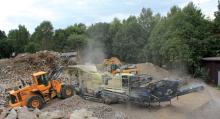Located in Bronkhorstspruit, at the Gauteng and Mpumalanga border in South Africa, a three-year old producer of high-quality silica sand has resorted to technology to take the load off weight problems on site. A key operational headache in recent times was the loading of incorrect tonnages in customer trucks, which resulted in huge losses of high-value material and unwanted downtime. To sort out this operational setback, the sand quarry approached JBI Industrial Solutions, the sole supplier of the Pfreundt range of load-weighing systems in sub-Saharan Africa.
JBI Industrial Solutions is a young company that opened its doors in 2018, but it is led by a team of experienced partners who, collectively, have over 20 years’ experience in the industrial weighing market, with particular focus on mobile weighing solutions and machine performance analysis.
JBI offers solutions to a range of applications, including weighing solutions and systems for mobile equipment such as wheeled loaders, conveyor belts, dump trucks and excavators. The systems are integrated with up-to-date software solutions that assist with production and productivity analysis.
“We had a problem with our loadout processes on site. We were either under- or overloading trucks, and this would only be discovered at the weighbridge. Consequently, the truck would need to come back to load the correct tonnage. This resulted in unnecessary downtime and high costs associated with re-handling of material and wastage,” explains the mine manager.
Christiaan Luttig, marketing director at JBI Industrial Solutions, says his company started working with the sand producer in February this year. He explains that because the sand producer deals with high-quality material, when every truck is loaded, it has to go through quality control where a physical sample has to be taken. If the sample passes, the truck can then proceed to the weighbridge.
The process is time consuming. “A big problem here was that in case of an overload, the truck could not just dump the excess material on the stockpile because, given the high-quality nature of the material, there are high chances of cross contamination. The material would be dumped on the waste pile, where it had to be refed into the processing plant for rewashing. In essence, the sand mine was losing about 34tonnes of material on every truck overload,” explains Luttig.
The sand producer then approached JBI for a weighing system for its Kawasaki 85Z5 wheeled loader responsible for stockpiling and loading customer trucks on site. “We wanted a solution that could enable us to load trucks correctly for the first time,” explains the mine manager.
JBI suggested its German-made Pfreundt WK60-S, a compact and maintenance-free weighing system. It allows for dynamic weighing while loading. The system is also precise, fast and accurate within +/- 1%.
Jaco Beukes, managing director of JBI Industrial Solutions, says, as standard, the WK60-S can store five users and five additional attachments. The system comes with interfaces for printers, network (LAN), CAN-Bus, power supply, as well as radio data transmission via WLAN, GPRS and GPS positioning. “With this system, quarry managers always know how much material is being moved – this saves time, lowers costs and improves operations,” says Beukes.
The system’s pressure transmitters are connected to the loader’s pressure lines. From there, a cable runs to the front of the cab, where it is connected to the trigger, which measures the weight. A proximity switch is installed on the bucket. “This is to make sure that the bucket is completely rolled backwards when loading and is fully opened forwards when dumping to make sure that all the material is out of the bucket to avoid carrybacks,” explains Beukes. The system also prevents the operator from continuing to load if they are not tilting the bucket enough, either backwards or forwards.
Every time the operator starts the loader, the scale asks them to do three warm-up lifts. This happens every time when the machine has been switched off completely. After the warm-up stroke, the system compels the operator to reset to a zero reading. Beukes says with traditional systems the operator had to do it manually and most of the time they forget, resulting in false loads. “Every time the operator starts a new load, the system asks them to reset to zero to keep the accuracy within the 1% allowance,” adds Beukes.
Apart from removing guesswork out of the loadout process, the load-weighing system has significantly helped with production planning on this particular site. As part of the project, JBI has also helped the sand producer to identify and log the different types of product onto the system. Each product is linked to a specific bunker where it is stockpiled. When loading, the operator captures onto the system the product being loaded, the location they got it from, the truck number, the customer and order number. By the time the truck gets to the weighbridge, all the information is already loaded onto the system.
At the end of the day, the manager has a good grasp of the total number of trucks loaded, the product they loaded and the recipient customers. The system, which is connected to cloud-based software, also informs the manager on the amount of material left on each product stockpile, allowing him to keep track of the stock count every time, thus informing production planning.
The loader stockpiles material from the four belts of the processing plant. Each belt produces a different size of sand, namely -1mm, -500 micron, 2mm and 4,75mm. On the scale, the operator selects the product they are stockpiling at a given time, allowing the quarry manager to see the amount of material available on each stockpile.
“The system keeps me updated on all fronts. I can see which truck is being loaded, how many tonnes they are loading and how much material is left on the stockpile. We can also do the bucket test to see the tonnes per hour being produced from the four different belts,” explains the quarry manager.
“Apart from making sure that trucks are loaded correctly the first time, which has a significant impact on our uptime, the load-weighing system also informs our production planning. We can see our tonnages in real time, which is very important for us. We have removed guesswork out of our planning and loadout processes,” he adds.
Having realised these operational gains, the sand producer is planning to install a second Pfreundt system on its Bell wheeled loader used to feed material into the processing plant. This will inform the amount of feed material going into the plant, against the amount of material coming out at the four belts.
In conclusion, the quarry manager believes every wheeled loader working on a quarry site should have a load-weighing system. “After realising the massive benefits of this system, my advice is that every loader on a quarry should have a scale installed on it. It makes a huge difference,” he concludes.









